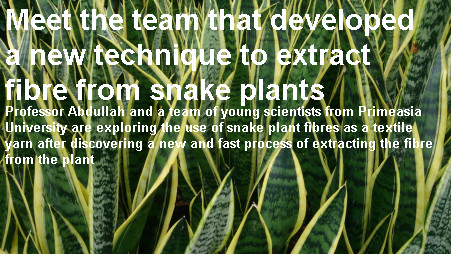
Category: FIBRES
Country: Bangladesh
By Kamrun Naher | 28 September, 2022, 09:00 am | Last modified: 28 September, 2022, 06:14 pm
At Phokir-Bari garden in Kapasia, he found a bush of this plant - with long sword-shaped, thick scale-like leaves, almost like a hardy succulent. The mature leaves were dark green with light grey-green cross-banding, like a snake print.
There, in the bush, while a few of the leaves had sharp tips, some had torn in places and Sabbir noticed there was a fibre-like interior to them.
Being a student of textile engineering, Sabbir found this fascinating and collected a single plant from the bush to study it.
It was a Snake Plant or Sansevieria trifasciata, that Sabbir had picked.
As an air-purifying ornamental plant, snake plants are generally kept indoors and in gardens. This genus has about 70 species, ranging from succulent desert plants such as Sansevieria pinguicula to thinner-leafed tropical plants such as Sansevieria trifasciata. It is native to India, Indonesia and Africa.
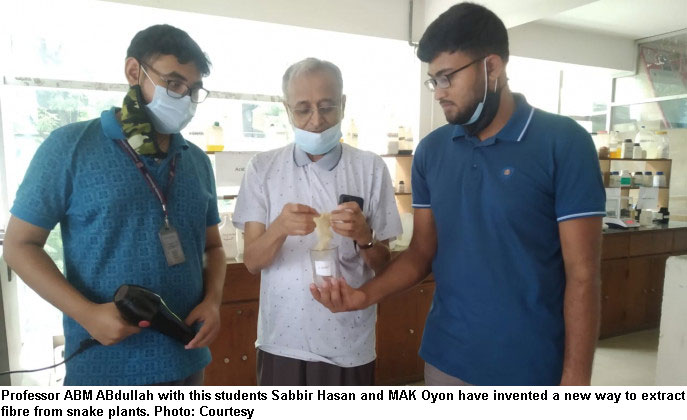
"Sansevieria species are believed to act as good air purifiers by removing toxins such as formaldehyde, xylene and toluene from the air, thereby gaining a reputation as a good option for indoor and garden plants. It converts CO2 into O2 at night," Sabbir said.
But what attracted him more is the fibre-y content it had.
He shared the idea with his friend MAK Oyon and the two began looking for someone who could guide them through this.
"Finally one of our seniors told us to find Professor ABM Abdullah, one of the faculties of the department of textile engineering at their alma mater," said Sabbir and Oyon.
Professor Abdullah is a scientist who has worked in the jute research institute for 30 years. He developed fibre and yarn from jute for the first time which was used to make the Jamdani saree.
"In my long career as a scientist and then later as a teacher, I must admit that I have encountered only a few research-enthusiasts. When Sabbir and Oyon came to me with a plant in a pot and curiosity in their eyes, it brought me immense joy to have found two such students", Abdullah said. That day he suggested Oyon and Sabbir study this.
From the initial studies, they found out that the plant does have fibrous content inside. In a 2013 publication, titled 'Extraction of fibre from Sansevieria trifasciata plant and its properties,' the researchers and writers Dr Rita Kant and Preeti Alagh saw how the snake plant fibre can be turned into textile yarns.
"This could be another solution to the trash-producing textile industry," Professor Abdullah reiterated the fact that there is a worldwide demand for eco-friendly, biodegradable, recyclable and reusable properties for textile production.
According to the Professor, cellulosic and lignocellulosic fibres such as cotton, jute, kenaf, ramie, etc are gaining focus and the international fashion industry now wants such natural fibre yarns to make clothes. Cellulosic and lingo cellulosic fibres are bio-polymer which can be extracted from a large variety of plants and crops such as banana, bamboo, water-hyacinth, etc.
"Fibre extraction from snake plants is not new as we found a few research papers on this. What we wanted to find out is if it's easy and affordable to extract fibre from the plant, and if the fibre is durable enough to be spun and made into fabric," Abdullah said.
So for the study, the primary sample (matured Sansevieria trifasciata L. leaves) was collected from where Sabbir brought the initial plant – the Phokir-Bari garden, Kapasia, Gazipur. Their core objective was to identify fibre extraction methods and other physical properties such as fibre content, chemical composition, fibre strength, diameter, colour, length, moisture content, etc.
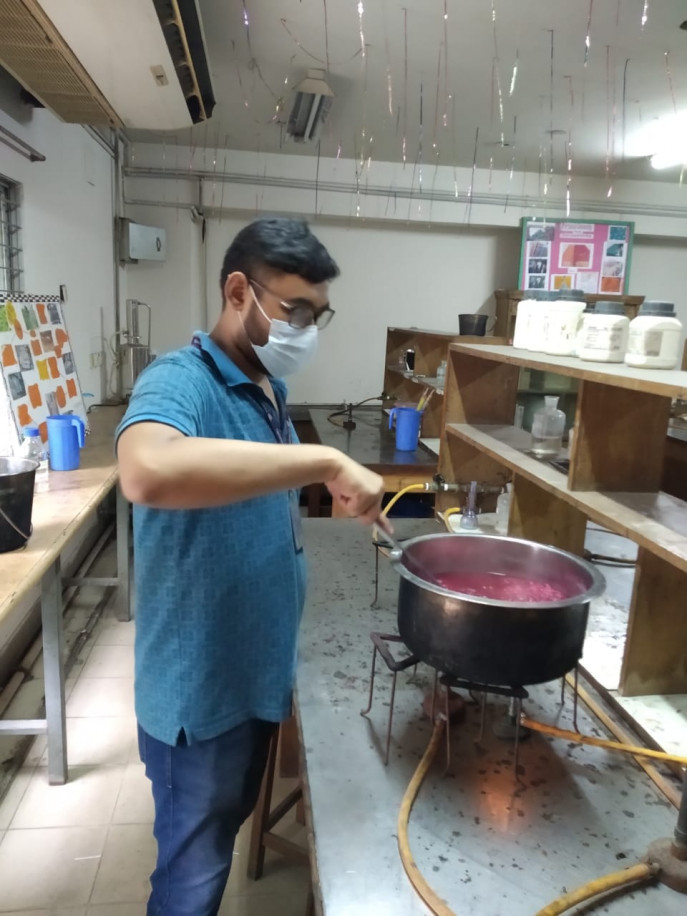
Photo: Courtesy
The team published their initial research paper from the Asiatic Society of Bangladesh in 2020 and currently they are experimenting with the fibre. Recently, fashion designer Bibi Rusell posted a photo on her social media page where she is seen sitting with Professor Abdullah and the team with this fibre in their hands.
"Bibi said she wants to work on this fibre, just like she had made Jamdani from the jute yarn that I developed," the Professor told The Business Standard.
Resonating with the words of the Professor, Bibi Russell said, "This is absolutely fantastic. This is big news. I have worked with Professor Abdullah before and was aware of this development from the start. When the fibre is ready and they hand it over to me, I will start working on it with the weavers."
Bibi said she wants to explore the use of this fibre in diversified products in fashion and household items. She said, "In Bangladesh, most of the raw materials to make yarn have to be imported. But if we can source the raw material locally from snake plants, or create a composite yarn mixed with imported raw materials, it would be a game-changer."
A new technique of retting
Whether the fibre is easy to extract or not, depends on the time it takes to liberate them from the leaves.
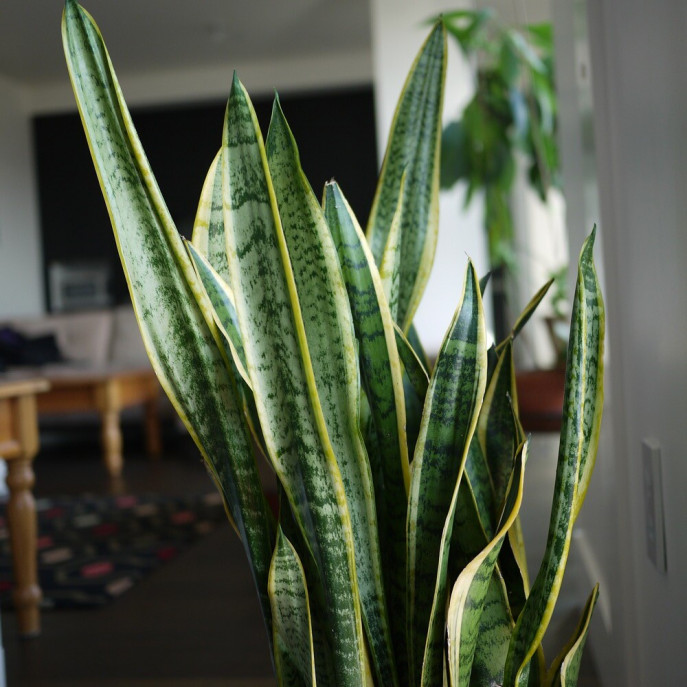
Photo: Courtesy
"In academics, the process is called retting," Professor Abdullah continued, "which is basically the process where the pectic material that binds the fibres to the leaves or stem, is broken down and the fibres are liberated."
And there are many ways to do that - manually by hand, water retting, dew retting, chemical retting decortication, etc. "Water retting takes three weeks to extract the fibre, which is a long time. We wanted to come up with a quicker procedure," Oyon said.
And so the team came up with a Chemi-Biochemi-Mechanical process that accelerates the retting process with minimal water and in minimal time.
In the laboratory of Primeasia University in Banani, they continued their research and discovered a new process that produced clean, gray-white, shiny and bright fibres in 48-72 hours, whereas in mechanical, chemical and water retting, it took three weeks.
Green leaves were cut down into 2-3 inch pieces after gently hammering it. After a number of experiments, they found out the perfect combination of retting time, pH, liquor ratio, the concentration of alkali, urea and molasses.
After retting, the fibre was thoroughly washed with tap water until it was freed from colour and waxy materials, and finally, it was washed with distilled water. Hydro-extracted fibres were dried at room temperature in an open atmosphere.
"These fibres can be scoured, bleached and even dyed in commercial dyes. We need to do more experiments to find out the potential," Abdullah said.
Better than jute and banana fibre
From 500gm of hammered leaves, they got 16 to 17 gm of fibre, which is almost 3%, whereas in jute and banana, the fibre content is 2% and 2.6%, respectively. Banana fibre is also coarser and shorter in length, with less cellulose content.
"The number of fibres from a single leaf, strength, diameter, and moisture content - everything shows a positive sign. But the poor crispiness indicates its spinnability is less than cotton/jute. Still, there is enough potential for it to be used in handicraft as a string, cord, decorative materials in boutique production and decoration of Jamdani and Katan products," Professor Abdullah said.
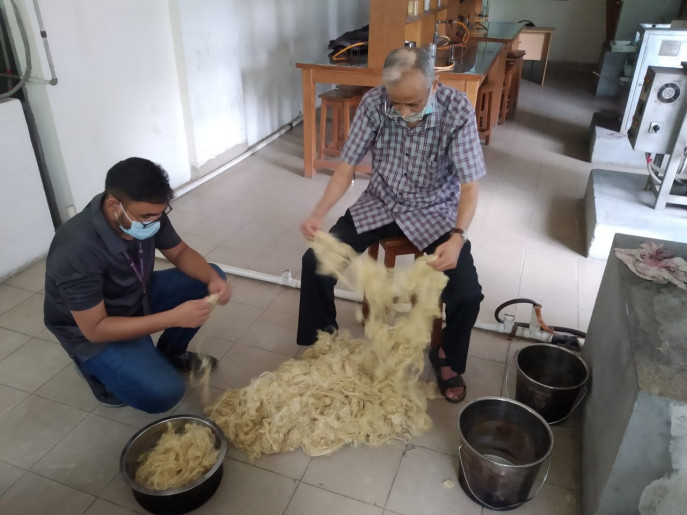
Photo: Courtesy
He continued by saying that this natural fibre-producing plant can grow anywhere in full sunlight, shade and even in the dark, but thrives in moist, fertile land with high organic content, with minimum or no agronomic care - which means this plant can grow well in Bangladesh.
So this is a great opportunity for us to venture into this organic yet unconventional fibre production.
Not just textile fibres, but more
In a 2015 study titled 'Development of Sansevieria trifasciata-carbon fibre reinforced polymer hybrid nanocomposites' by Murthy, V.N. and N. Karthikeyan; the scientists came up with the result that the roots of snake plants have the potential for the production of various nano products, along with some medicinal values. Due to the presence of flavonoids, they can be used as an antibacterial and antioxidant agent as well as an inhibitor of the xanthine oxidase enzyme, which is the main culprit of hyperuricemia.
Besides, it plays a significant role in curbing air pollution. It purifies the air by absorbing toxins through the leaves and producing pure oxygen. While most other plants release carbon dioxide in the absence of photosynthesis during the night, the snake plants produce oxygen.
Courtesy: https://www.tbsnews.net/features/panorama/meet-team-developed-new-technique-extract-fibre-snake-plants-504458
Copyrights © 2025 GLOBAL TEXTILE SOURCE. All rights reserved.